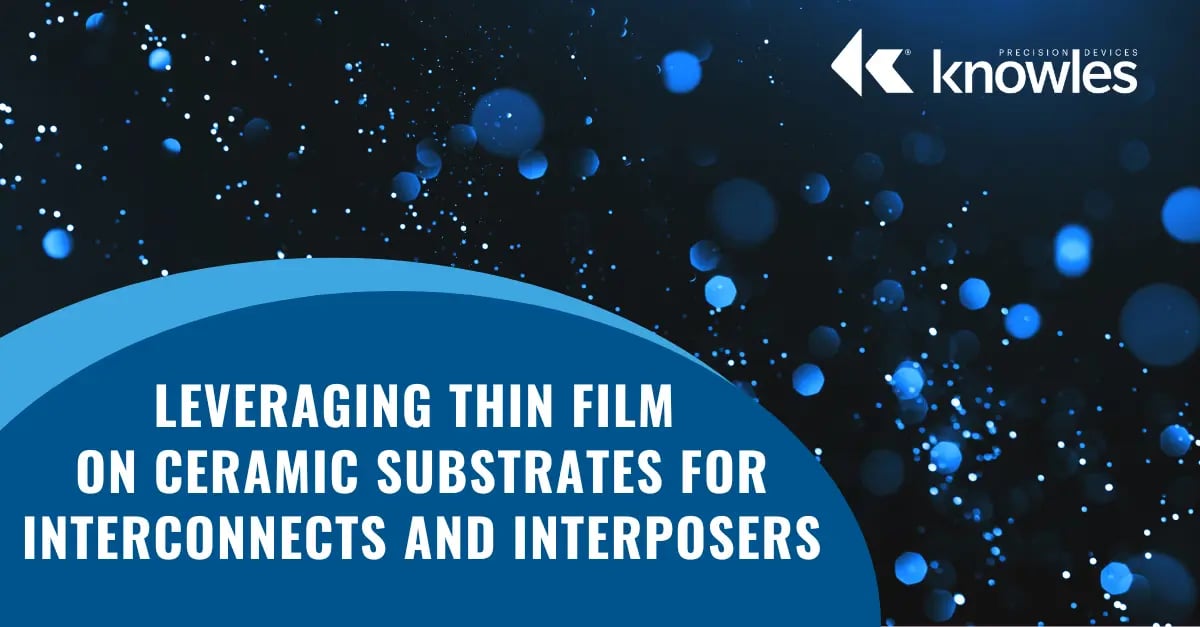Innovation in advanced packaging was driven, in part, by advancements in interposer design and construction. Interposers are electronic components designed to sit within a package and connect different circuits and components via interconnects. Thin film interconnects are standard in high-frequency components and subsystems where transmission line widths are small (i.e., .005” and under) to improve overall system performance. They also support high-power applications where thermal conductivity is more of a concern and certain materials like beryllium oxide and aluminum nitride are more commonly used.
Ceramics-Based Interposer Design
Ceramics were one of the first materials used as substrates for mass-produced electronics, and they’re still used for packaging and interconnects today. Thin film on ceramics is ideal for surface interconnects with dense circuits. The ability to leverage the high reliability of ceramics while creating more complex, dense designs is particularly helpful in military applications and other applications where systems can’t quit. With a low dielectric constant and low loss tangent, which minimizes signal loss at high frequencies, thin film ceramic interposers are well-suited for RF and microwave applications.
Interposer Construction
There are several key steps involved in applying thin film on ceramic during interposer design and fabrication.
Materials Selection
Choosing the appropriate ceramic material for an interposer is the first step in robust interposer design. The most common materials include alumina (AI₂O₃), aluminum nitride (AIN), and low-temperature, co-fired ceramic (LTCC). Operating frequency, thermal conductivity, cost constraints, and other application-specific requirements determine which of these materials best support the design. Knowles Precision Devices offers a wide variety of substrates, including standard and proprietary ceramic formulations, to ensure final components meet all application-specific requirements.
Thin Film Deposition
Once the team identifies the ideal ceramic substrate material, techniques like sputtering, evaporation, and electroplating are used to deposit a thin film of conductive material (e.g., gold, silver, or copper) on the surface. Film thickness typically ranges from a few nanometers to a few micrometers depending on application requirements. For example, conductors may require a thicker layer of film, approximately 1μm, and a thinner layer of film, approximately 0.01 μm thick, may be more suitable for resistors.
Patterning and Etching
After thin film deposition, circuit patterns are drawn onto the ceramic substrate using photolithography, laser ablation, and other patterning techniques. Through selective etching, unwanted conductive film is removed, so all that remains is the desired circuit pattern. Key specifications for the end product determine which circuit building blocks and integrated passive devices (IPDs) should be embedded in the thin film.
Via Formation
Vertical interconnect access points, otherwise known as vias, in the ceramic substrate create electrical connections between layers and components. Vias are formed by drilling holes through the substrate and filling them with conductive materials (e.g., tungsten, copper, or silver).
Interposer Design with Knowles Precision Devices
Thin film ceramic interposer design offers several advantages in RF and microwave applications. Designers can expect reduced signal losses, more effective thermal management, and more opportunities to reduce component size. Optimizing performance and reliability for specific applications starts with careful consideration of materials and manufacturing processes.
For more information on thin film interposer design and Knowles Precision Devices’ build-to-print services, see our Build-to-Print Best Practices Guide and our in-depth Build-to-Print Basics ebook, which includes valuable information about our process.



